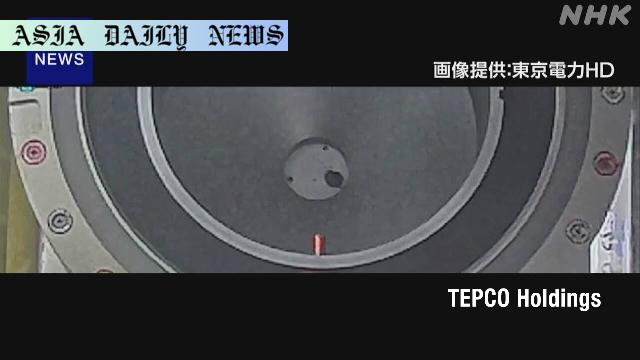nuclear fuel debris, estimated to be a few grams, was grasped and safely measured for radiation levels ensuring worker safety.
TEPCO completed the second trial of nuclear fuel debris retrieval at Fukushima Daiichi’s No.2 unit.
A small amount of debris, a few grams, was safely extracted and measured for radiation levels.
The safely stored debris will undergo analysis at a research facility in Ibaraki Prefecture.

Introduction: A Breakthrough in Nuclear Disaster Management
Tokyo Electric Power Company (TEPCO), operator of the severely damaged Fukushima Daiichi nuclear power plant, has achieved a significant milestone in its ongoing effort to manage and mitigate the consequences of the 2011 disaster. The facility, which faced a catastrophic meltdown following the devastating earthquake and tsunami, remains a testament to the complexities of nuclear recovery. As of April 17, TEPCO successfully completed its second trial process for the retrieval of nuclear fuel debris from Reactor No. 2.
The Context: Untangling a Legacy of Destruction
Fukushima’s frontline battle against radioactive waste involves the challenge of addressing approximately 880 tons of molten nuclear material. This unprecedented mix of melted fuel and structural debris is a lingering reminder of the tragedy that struck northeastern Japan over a decade ago. The No. 2 unit has been a focal point due to its accessibility and perceived feasibility in testing safe retrieval technologies. Last November, TEPCO conducted its first trial, and building upon those results, inaugurated the second test process in April 2023.
The Process: From Containment to Transport
In the latest venture, a specialized retrieval device was remotely operated to extract a small quantity of fuel debris. The estimated few grams of material, carefully controlled and maneuvered, were subsequently analyzed outside of the containment vessel. Initial assessments of radiation levels indicated that the materials posed minimal risk to worker safety, thereby justifying their transportation to a secure metal box. This marked a critical step in validating the safety and effectiveness of TEPCO’s operational protocol. In a final stage of the trial, the debris was encased in a specialized transportation container to ensure secure transfer to a dedicated research facility in Ibaraki Prefecture, where it will undergo advanced analytical procedures.
Future Implications: A Path Toward Resolution
While the amount of extracted debris may appear negligible, the importance of this trial lies in its broader implications. Japan’s efforts to develop feasible methodologies for the large-scale retrieval and safe handling of radioactive material hinge on these incremental advancements. The knowledge gained from analyzing these small samples is invaluable for refining technologies and ensuring the safety and efficiency of future large-scale operations. TEPCO’s meticulous commitment to ensuring minimal radiation exposure to workers demonstrates a sustainable approach to managing nuclear hazards.
Conclusion: Strides Toward a Contained Future
The completion of this second test represents more than just a procedural success; it epitomizes a nation’s resilience and tenacity in addressing one of the worst nuclear disasters in history. TEPCO’s ongoing efforts to safely retrieve and analyze nuclear fuel debris underscore a continued commitment to innovation, safety, and environmental restoration. As the retrieved material undergoes further scrutiny in Ibaraki Prefecture, the world watches intently, recognizing the global stakes in developing effective nuclear recovery strategies.



Commentary
The Significance of TEPCO’s Achievement
TEPCO’s successful completion of the second trial retrieval of nuclear fuel debris at Fukushima Daiichi Unit No. 2 represents more than an operational milestone; it serves as a beacon of hope and progress in the face of seemingly insurmountable challenges. The deliberate and meticulous approach taken by TEPCO underscores the importance of advancing nuclear recovery technology while ensuring the safety of workers and the environment.
Incremental Progress: The Key to Success
Small victories, such as the safe extraction of a few grams of nuclear fuel debris, provide critical learning opportunities for researchers and engineers. These insights pave the way toward developing large-scale solutions to address the massive 880 tons of radioactive waste still inside the Fukushima reactors. The dedication to incrementally improving safety measures and retrieval processes highlights the careful balance between urgency and caution in the nuclear recovery sector.
The Broader Impact on Nuclear Policy and Safety
TEPCO’s advancements also have far-reaching implications for global nuclear policy. As nations around the world grapple with the management of nuclear waste and the decommissioning of aging facilities, the methodologies and technologies being developed in Fukushima could set new standards. The international community has an opportunity to learn from Japan’s perseverance and innovation, fostering collaboration and shared expertise to mitigate nuclear risks.
Looking Forward: Hope Amidst Challenges
While the road to fully containing and dismantling the Fukushima Daiichi plant is long, TEPCO’s progress demonstrates that even the most daunting challenges can be addressed with determination and ingenuity. This achievement serves as a reminder of the resilience of both technology and humanity in overcoming adversity. As further trials and large-scale operations are undertaken, the lessons learned will not only aid Japan but also contribute to the broader understanding of nuclear recovery and safety worldwide.